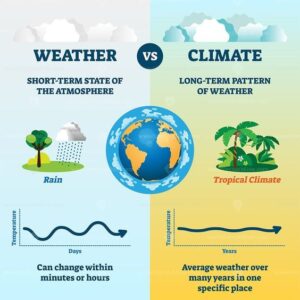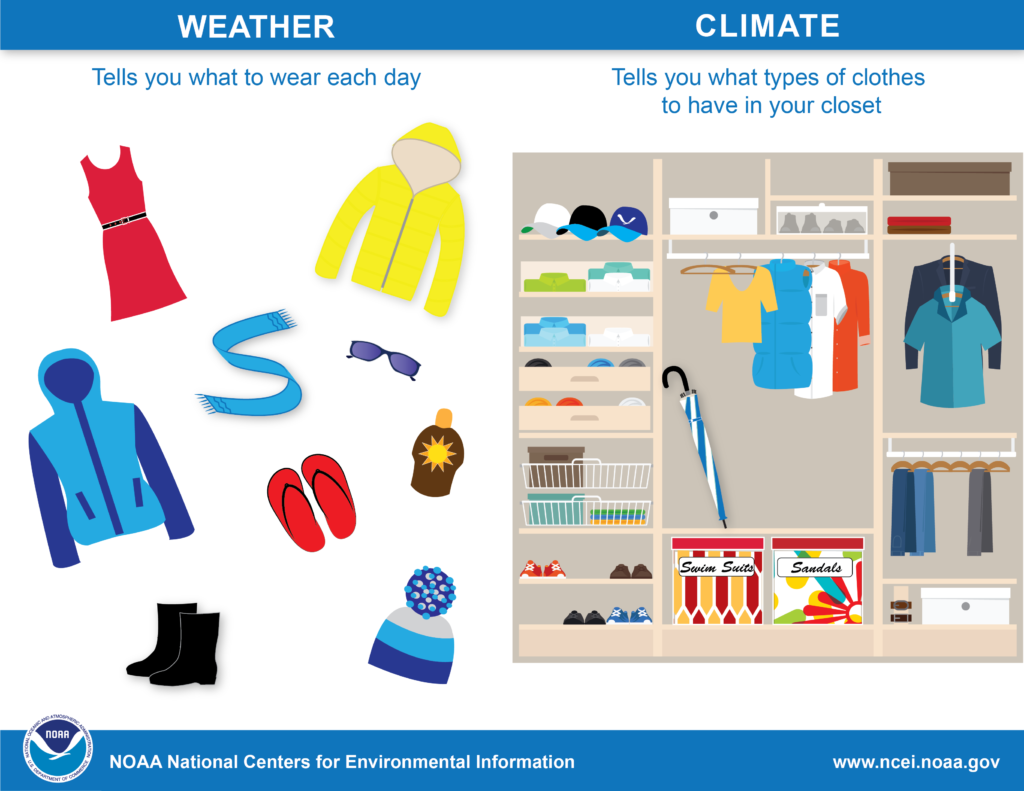Chapter 1: What is Climate Change and Why Care?
Inquiry 3: Understanding Climate Change
- Provocations – Poster
- Question Generation – Umbrella questions,
- Knowledge Building– Umbrella Questions, Knowledge Building Circle
- Determining Understanding – KWL
- Pursuing Learning – videos, science experiments,
- Consolidation – illustrate, visual processing cards ($)
- Assessment – Graffiti wall
- Take Action
To hook student interest, introduce the provocation idea to initiate student thinking using the following pictures.
Posters
Posters can be a great tool for education and motivating children.


*This is a very difficult concept for young children who are very literal. They have challenges seeing the closet as climate. This video might also help the teacher and students see the patterns Trend and variation (challenging vocabulary).
- Display the weather picture first. Have a discussion as to what they observe in the picture.
- Display the climate section of the poster. Have a discussion as to what they observe.
- Read the subtitles under each title. Have a discussion about the meaning of each subtitle and the relationship between the two.
- Come up with a class statement that explains the difference between weather and climate.
Potential Questions:
- When would you wear a toque? Or a raincoat? Or flip flops?
- Does the weather change from day to day?
- Can we plan ahead for the weather?
- Do we have an idea of what kinds of weather we have in each season?
- What would it be like if the seasons didn’t change?
- What if we had snow in the summer or no snow in the winter?
At this point in the inquiry, we want to harness students’ curiosity and build off the provocation that has captured their interest by generating meaningful questions to continue to drive the learning process.
Poster Follow up
After observing and discussing the differences between weather and climate, invite students to develop Umbrella Questions focused on the “big ideas” of climate change. Post the questions around the poster. These questions will help ground the inquiry.
At this stage, students may be ready to engage in a group knowledge building activity. It will encourage students to open their minds to many alternative ways of thinking about the provocations and ideas that have been generated thus far in the inquiry process.
Engage in a class Knowledge Building Circle (outside is recommended if possible) using one of the questions that you generated after the poster provocation or the example below.
Possible Umbrella Question: “How does Climate Change impact our world?”
Use responses to inform and guide the learning process. They can provide insight into which concepts need clarity, what many students are already well informed about, and a general direction that many students want to pursue.
Based on students’ questions or the Umbrella Question: How does climate change impact our world?, work together with your class to fill out the “Know” and “Want” columns of a KWL (Know-Want-Learned) Chart.
Sample KWL Chart:

At this stage, students may begin research to pursue their umbrella questions, or the following activity could be integrated into the process to ensure that students have an understanding of foundational climate science and enrich their understanding of climate change.
Video and experiments
The following climate change video helps to consolidate climate change vocabulary such as the greenhouse effect and global warming. We encourage teachers to watch the video beforehand and identify the teachable moments or sections applicable for your age group.
- Watch the video: Climate Change for Kids | A fun engaging introduction to climate change for kids
- After you have watched the video, choose one, two or all three of these Climate Change Science Experiments For Kids to help the students understand climate change.
Extension: Video
The video explains how climate change refers to long-term shifts in temperatures and weather patterns, mainly caused by human activities.
This step is designed to encourage students to integrate and synthesize key ideas. When students make connections and see relationships within and across lessons, this helps them to solidify knowledge and deepen understanding.
Illustrate
Have the students show their learning about climate change with playdough, illustrations or movement in groups.
AND/OR
Visual processing cards: (these would need to be purchased)
Using a deck of visual processing cards (chiji or climer cards), spread these out on the floor or on a table. Ask students to pick a card that reflects something that they have learned today. This is ideally facilitated in a circle.
Teachers will assess learning at different points throughout the inquiry using multiple methods. The following assessment provides an alternative evaluation method to standard quizzes and tests that can be used after consolidation or at any point in the lesson to check for understanding.
Tell the students they are school artists and have been invited to explain to the school community about climate change. They have been given a space on a wall called a graffiti wall.
Divide the wall into 3 and ask students to visually represent their ideas and opinions about weather in the first third. The other two thirds will be filled over the course of the next two inquiries (climate and climate change).
Spend some time learning about the history of graffiti: Graffiti Facts for Kids.
Once the students have a good understanding of weather, climate and climate change, allow time for students to take action. This is an essential part of the learning process on climate change, as it empowers students and eases their eco-anxiety. Remind students that even when things get hard and seem so big they can always do something by taking action. Their actions will create an impact.
These ideas for action can be utilized at any point in the learning process, whether it’s now or after completing more guided inquiries. Please note the suggestions are consistent in each chapter.
Ask the students what they want to do to positively impact climate change. List their ideas and come up with a plan to put their action in place.
Ideas for Taking Action:
- Organize an assembly to present information learned in an engaging manner
- Plant trees
- Collect data as a citizen scientist (e.g., bird counts)
- Encourage families to use eco-friendly options in place of single-use items (e.g., plastic water bottles, paper coffee cups, etc.)
- Take a class pledge to make changes:
- Use both sides of paper
- Turn off the lights when leaving the room
- Unplug things that aren’t being used
Or check out these ideas: 50 Classroom Climate Actions – Resources and Descriptions
Action Project Examples
How could you use these great examples to come up with Action Projects with your students?
“POLLINATOR GARDEN” –Algonquin Public School- Woodstock, ON (2017) K-2
- The main focus of the project is to inform and support young children in developing their understanding of insect life cycles and the interconnectedness of the beautiful creatures to our lives and to begin to foster an appreciation for nature and how they can have a direct impact on their local and national environment. They learned about the decline in the Monarch Butterfly populations during a professional development workshop and decided to plant a pollinator garden. See their project here.
- Ten Canadian Schools’ stories of Climate Action
- This document outlines a collection of promising practices of climate action taking place in 10 Canadian UNESCO Associated Schools. These 10 schools participated in a worldwide UNESCO pilot project to implement climate action as recommended in the UNESCO (2016) publication, Getting Climate-Ready: A Guide for Schools on Climate Action. https://bit.ly/3mpPtiY
- Young Voices for the Planet
- This website documents youth speaking out, creating solutions and leading the change. These youth solutions to the climate crisis include stories of California kids banning plastic bags, Florida students saving their school $53,000 in energy costs, an 11-year-old German boy planting millions of trees and other young people changing laws, changing minds and changing society as they reduce the carbon footprint of their homes, schools and communities.Young Voices for the Planet
- Resources for Kids Taking Action: Young Voices for the Planet | Award-Winning Film Series and Civic Engagement & Democracy Curriculum | For Kids
- The Great Plant Hunt from Ecoschool Global
- The campaign aims to educate students about biodiversity, its importance and encourages them to take positive action. About the Campaign — Eco Schools
- Warming, Waste, Water, Watts, Wildlife (W5)
- Through this project, thousands of students will be given opportunities to assess, design, and build innovative solutions to environmental challenges. Warming-Waste-Water-Watts-Wildlife (Alcoa W5) — Eco Schools
- Community Conversations for Climate Change
In this activity, students talk to members of their community about some of the environmental and climate changes they have noticed since they were young. Community Conversations for Climate Change | The World’s Largest Lesson